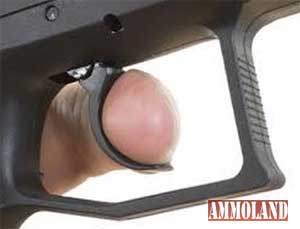By Tom McHale


USA –-(Ammoland.com)- We humans don’t lack confidence. Hitting targets low and left we may quickly assume the worst of our pistols. How to not jerk the trigger, another range tale to be told.
A couple of years ago, I was assistant coaching a youth Steel Challenge team. Every other week or so, we would get a new shooter or two, usually between the ages of 12 and 16. One week, I had a new young man, about 15 years of age as I recall.
To protect the innocent, but exceptionally confident, let’s just call him Frank “Ponch” Poncherello.
Anyway, after taking Ponch through a pretty comprehensive safety briefing on the four rules and safety procedures at our range, it was time to get Ponch shooting. He had shot guns before, including pistols, so we went straight to the team’s Springfield Armory XD 9mm. Yeah, it’s a nice gun and certainly not known for accuracy problems.
After unloading at steel plates for a couple of magazines, Ponch turned to me and said, with a serious straight face, “the sights on this gun are off – it’s shooting low and left.”
Ponch’s casual observation took me back to 1999 – the year before all the ATM’s started spitting out buffalo nickels and nuclear missiles launched themselves towards Possum Kingdom, South Carolina. I was at a local indoor range, shooting with my business partner Mike. At the time, I knew even less than I know now, and he was our shooting expert. He had his Sig Pro 2340 .40 S&W and we were enthusiastically blowing a paper target around with the breeze from nearby misses. In fairness to our shooting skills, the target was at least 10 yards down range, so gimme a break already, will ya? Mike was shooting first, and kept hitting low and left. Bluffing like a shooting master, I ribbed him about his skills, until he told me to try his gun. When I did manage to hit paper, my shots were low and left too.
Quickly ruling out Justin Bieber as a possible cause for accuracy problems, we tried to figure out was going on, never stopping to consider the remote possibility that it might be shooter error. After some contemplation, Mike found the cause, and I readily agreed as it exonerated the both of us from an embarrassing shooting performance. Earlier, Mike had loaned his gun to a TV show production crew and the budding action star had dropped the gun during filming.
Clearly this was the cause as the drop must have knocked the sights out of alignment. What else could it be?
Just to be sure, we called the range owner over to verify our findings. This turned out to be a very bad idea. The range owner, let’s call him Yukon Cornelius, proceeded to pick up the Sig Pro 2340 and knock the center out of the target. He didn’t even pause to aim carefully. Trying, and failing, to stifle a laugh, Yukon looked at us and said “you’re jerking the trigger.”
At least I think that’s what he said anyway, I could have sworn he said “you guys are a couple of jerks who can’t hit the backstop.”
Either way, we were humbled and started to figure out that maybe the shooter has something to do with that low and left sight alignment problem.
Back to Ponch the young commando trainee. Also trying, and failing, to not chuckle at my new shooting protege, I told him “The sights are fine! You’re jerking the trigger!” I could tell he didn’t believe me for a second and remained convinced the sights were off. After all, he had aimed them straight at the target, then pulled the trigger!

At this point, I had him clear the gun and we proceeded to have a lesson in the importance of trigger control – especially when shooting pistols. You see, pistols require at least three or four pounds of pressure to fire the gun, and usually more, all the way up to twelve pounds or so.
That sounds OK until you realize that the pistol itself almost weighs less than the required trigger pressure. So when you exert force to move the trigger, physics says the gun is really gonna want to move first. You have to do a stellar job of holding the gun perfectly still throughout the firing sequence. New shooters almost never get this until you explain the “force to press is heavier than the gun” principle, then the light bulb goes on.
The Cure
For purposes of the rest of this article, we’ll talk about the issues from a right-hand shooter perspective for simplicity. If you’re a lefty, just stand on your head and all the left / right references will make sense.
So if you’re shooting low and left, and are right handed, consider the fact that it’s your technique and not the gun’s fault. While people generally refer to the problem as “jerking the trigger” there are at least two distinct things that can cause that sort of miss.
First, there is a jerking the trigger phenomena. If you hold and empty, and verified safe, gun, point it at a safe backstop, and rapidly pull the trigger. The movement of your finger is an arc shape, which tends to exert force causing the gun muzzle to move left and down. The arc of your finger causes the “left” motion and the arc of the trigger movement causes the “down” part, along with the fact that the force is being applied below the barrel.
The other problem is sometimes called milking. With a safe and cleared gun (empty chamber and magazine!) hold your gun loosely and point it at a safe backstop. Now squeeze the grip like you’re shaking hands with Chuck Norris. Unless you’re cheating on this exercise, you should see the muzzle of your pistol dip down and to the left. That’s called milking for obvious reasons. The “milking” motion of your hand causes a similar downward and left movement.
Fortunately, these things are easy to fix with just a little bit of dry fire practice on a regular basis. No one ever believes me until they try it themselves, but I still propose that the very best way to rapidly improve your shooting skills is to NOT shoot bullets.
Rather, practice dry fire on a regular basis. By dry firing, you’re removing all the other distractions from the shooting process so you can focus on a smooth trigger press while keeping the front sight exactly on target. By repeating the sequence, perfectly, as there is no recoil, you’re training your brain that it’s OK to do this perfect trigger press thing and that it won’t be punished with a loud bang and recoil. With repetition, your brain will allow you to do the same perfect motion when you are on the range.
Here’s a link to a section from my book, The Rookie’s Guide to Guns and Shooting, that offers detailed instructions on how to practice dry fire with various firearms.
Try it – you’ll be amazed at the difference in your results.
Tom McHale is the author of the Insanely Practical Guides book series that guides new and experienced shooters alike in a fun, approachable, and practical way. His books are available in print and eBook format on Amazon. You can also find him on Google+, Facebook, Twitter and Pinterest.
